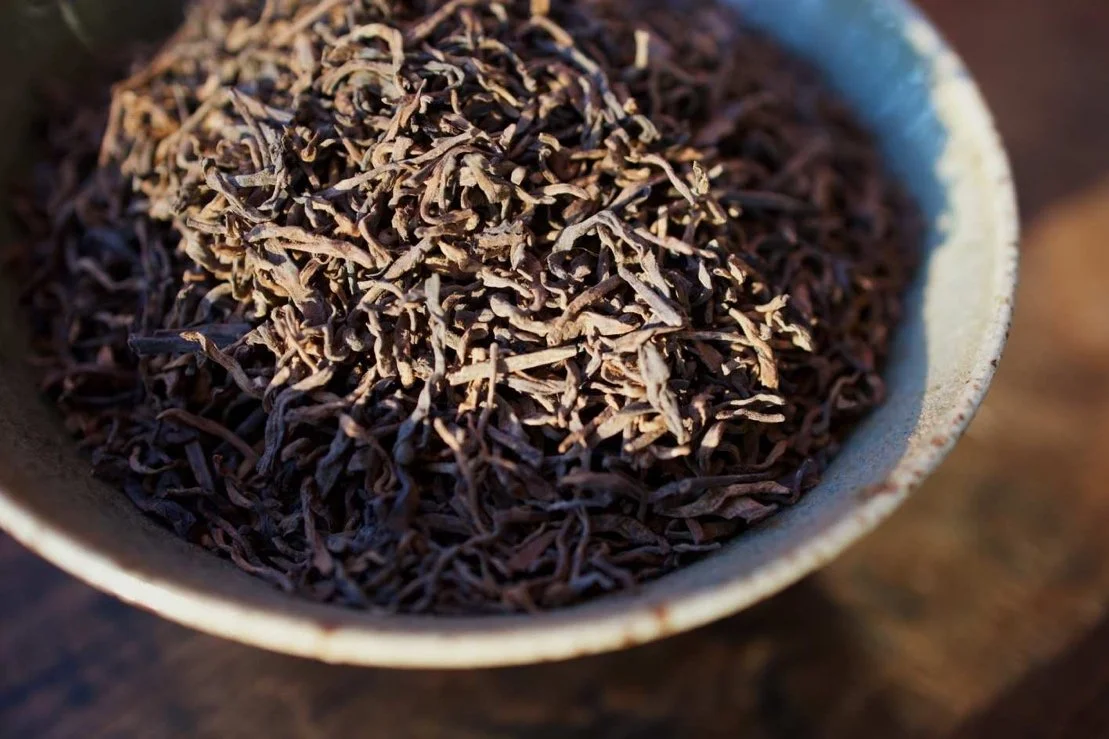The Art and Medicine of Pu’er Tea
Curated Teas at The Healing Order
Tea as Medicine & Ritual
In 1998, French and Chinese researchers made significant discoveries regarding the medicinal properties of Pu'er tea, particularly its potent effects on cholesterol and weight management. The key figures involved were:
Dr. Philippe Pau (France) – A researcher who collaborated with Chinese scientists to study Pu'er tea's lipid-lowering effects.
Professor Jiang Shixiong (蒋世雄) (China) – A prominent scientist from Kunming Medical College (now Kunming Medical University) who worked with French researchers to analyze Pu'er tea's impact on metabolism.
Key Findings (1998 Study):
The research suggested that fermented Pu'er tea (shou Pu'er) could help reduce blood cholesterol levels.
It was found to aid in weight management by promoting fat metabolism.
The study contributed to Pu'er tea's reputation as a "slimming tea" in international markets.
This collaboration helped validate some traditional claims about Pu'er tea's health benefits and spurred further scientific interest in its bioactive compounds (e.g., statins, polyphenols, and microbial metabolites from fermentation).
Because Pu’er tea is made from heirloom, deep-rooted, old-growth tea trees, it is uniquely mineral-rich. Unlike other teas, grown from a young tea plant bush, which may deplete bodily minerals due to their high tannin content, Pu’er draws essential trace minerals from deep within the soil, providing a nourishing and balancing effect. These old-growth trees can be as large as oak trees, with leaves 4 times larger than a young tea bush.
The Medicinal Value of Pu’er Tea
Chinese culture has long revered tea as a meaningful daily ritual. We now know that Pu’er tea, in particular, is highly medicinal, specifically providing:
Supporting digestion and gut health (rich in probiotics and digestive enzymes)
Detoxify the body (especially beneficial for the liver and blood)
Enhance cognitive function (supports dopamine and serotonin balance)
Reduce systemic inflammation (helpful for autoimmune conditions and chronic pain)
Promote steady energy without overstimulation (unlike coffee)
Heart Opening is supportive to deepening our ability to connect with others, as well as our own emotions
Experience the Living Art of Pu’er
Pu’er tea is a living tradition, a medicine, and a meditative practice. Originally valued and understood by Tibetan monks who recognized its ability to support the body long before research proved their beliefs to be true. Pu’er invites us to slow down, nourish ourselves, and connect to centuries of wisdom.
Tea as a Personal Prescription
At The Healing Order, we take an individualized approach to tea selection, recognizing that, like herbal medicine, tea should be tailored to an individual’s constitution and wellness goals. We encourage patients and tea enthusiasts alike to consult with their practitioner to determine which Pu’er tea aligns best with their health needs.
All of our teas are sourced from small-scale, wild, or semi-wild sources, sometimes even a single tree, from ethical producers who maintain the highest standards of ecological stewardship and quality. Each tea is tested and verified to be free of contaminants and rich in natural therapeutic properties.
Understanding Pu’er Tea: Sheng vs. Shou
Pu’er tea is traditionally categorized into two distinct types, each offering unique flavor characteristics and health benefits:
Sheng (Raw) Pu’er undergoes a slow, natural fermentation process over years or even decades. Initially possessing a bright, grassy flavor with floral undertones, Sheng tea develops complex, earthy, and smooth characteristics as it matures.
Shu (Ripe) Pu’er undergoes a controlled, post-fermentation process. The result is a dark, rich tea with a full-bodied, earthy aroma reminiscent of aged wood, chocolate, or forest floor. This variety offers a grounding, warming experience, well-suited for daily consumption.
Both Sheng and Shu Pu’er are considered living teas - they continue to evolve over time, offering a dynamic tea-drinking journey.
Our Curated Selection of Pu’er Teas
The Healing Order has carefully curated a collection of 5 premium Pu’er teas that reflect the ancient art of tea cultivation and the highest standards of sustainable sourcing.
2022 & 2024 Mangjing Shengcha (Jingmai Mountain)
Tasting Notes:
Dry Aroma: Wildflower fragrance
Infused Leaf: Vegetal bitterness with a hint of minerality
Liquor: Honey and orchid aromatics
This signature Sheng Pu’er is sourced from old-growth tea trees planted by the Mangjing ancestors of Jingmai Mountain. Carefully processed to preserve its vitality, this tea offers a balanced yet complex experience—an excellent introduction to naturally fermenting Pu’er teas.
2015 Shu Pu’er - Xiangtu Jingmaishan
Tasting Notes:
Palate: Rich, full-bodied, smooth
Storage: Naturally aged in Jingmai Mountain, allowing for the development of aged aromas
This Shu Pu’er offers a robust daily drinking experience and is an excellent foundation for those deepening their tea practice. Its fermentation process maintains the integrity of the leaf while producing a velvety, grounding tea.
Xiangzhulin Old Tree Pu’er (2017, 2022, 2023)
Region: Yunnan Lincang
Harvested from centuries-old tea trees in Gengma County, the Xiangzhulin collection is a testament to the art of Pu’er cultivation. These teas originate from a protected ancient tea forest, where trees over 200-300 years old produce leaves with exceptional depth and complexity.
Aroma: Highly fragrant with a long-lasting, elegant aftertaste
Flavor: Balanced sweetness, thick and full-bodied liquor
Aging Potential: Ideal for long-term storage, evolving beautifully over the years
Mijing Old Tree Pu’er (2023)
Region: Yunnan Lincang
Sourced from a Blang ethnic village near Bingdao, this Pu’er is made from early spring leaves of ancient trees between 100-300 years old. Known as "Little Bingdao," it boasts a powerful yet gentle energy, with an incredibly sweet and floral honey aroma.
Palate: Smooth, warming energy with a Taiji-like movement through the body
Sweetness: Exceptional sweetness that lingers on the tongue
2000 Wild Tea Garden Sheng Pu’er (Loose Leaf)
A rare and precious tea, this Sheng Pu’er was sourced 20 years ago from the "Tea King of Yunnan." With each passing year, its value and medicinal properties increase, making it a prized addition to any collection.









